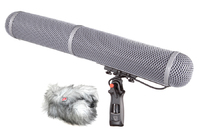Editor's Note: This is a draft of an article that I am working on for a major trade publication (to be announced).
 Here is my take on how to install microphones into your Rycote. I was surprised to discover that there is not much out there in the way of advice or instructions.
Here is my take on how to install microphones into your Rycote. I was surprised to discover that there is not much out there in the way of advice or instructions.
In the world of microphone wind protection, it is accurate to say that Rycote is considered the big daddy and the unofficial standard of the industry. For as long as I can remember — and that goes back more than a few decades — if you needed to use a shotgun microphone outdoors on a windy day, you mounted it in a Rycote (blimp) windscreen.
